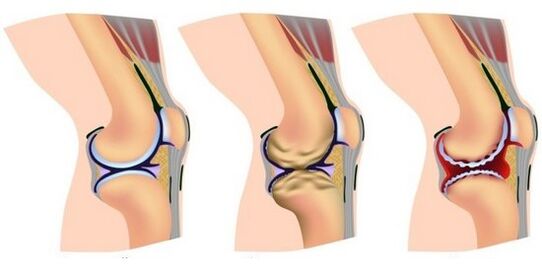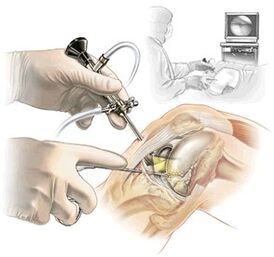
Knee pain is one of the most common unpleasant sensations that everyone has experienced at least once. The progression of diseases, due to which pain can appear, is due to the fact that the human knee consists of many structures, and every day they are subjected to colossal loads. The damage can affect one of the ligaments or tendons, or specific sacs that fill with fluid, as well as the cartilage. This symptom can be a sign of diseases not only related to the knee, but also general diseases of the body or systems.
It is also necessary to distinguish with what movements the pain occurs, for example, pain in the knee during flexion is inherent in people leading an active lifestyle, and often speaks of a violation of the structure of the joints and bones. Such spasms appear mainly in the later stages of the course of the disease, when it is impossible to do without treatment with the help of surgical intervention. Often the knees hurt and creak when squatting, this may indicate that the cartilage tissue is fading (observed mainly in athletes due to constant running). Pain inside arises due to various pathologies of the joint or the appearance of neoplasms. The appearance of pain after childbirth is due to the fact that during pregnancy, the female body underwent many changes, which could lead to the development of some diseases.
It is important to determine why the pain in the knee joint is expressed, because some diseases can be cured only with the help of an operable intervention, and for some it will be enough to use traditional medicine.
Etiology
As mentioned above, there are many reasons why knees hurt and they are not always directly related to knee joint injuries, illnesses, and bruises. The first group of factors is made up of disorders that directly affect the knee joint, among which are:
- Gonarthrosis is a disorder that most often affects people over 40 years of age. The pathology usually affects both knees. The main symptom is pain and crunching during extension and squatting. The spasms are sharp and sharp. The degree of intensity decreases when lying down;
- introduce blood into the joint cavity;
- Damage to the meniscus can occur at any age, regardless of gender. Often only one knee is affected. This ailment is characterized by the manifestation of a loud crunch and pain in the knee when bending or after running. In addition, a person loses the ability to move, because he experiences excruciating pain at the slightest movement of the leg;
- arthritis - the disorder develops very quickly, the inflammatory process spreads to the knee joints of both legs. It is better to start treatment as soon as possible because the disease has spread to other joints;
- violation of the integrity of the ligaments due to rupture, most often the internal ligament is susceptible to this, and much less often it occurs on the lateral. In this case, there is swelling and limitation of motor functions;
- various inflammations of the tendons, the appearance of which is due to many reasons, for example, infectious diseases or the influence of bacteria, trauma or bruising, drug allergies or abnormalities in the structure of the body. In such disorders, knee pain is expressed from within;
- displacement or dislocation of the patella - occurs very rarely and mainly in children or athletes, after strenuous exertion or running;
- inflammatory process in the articular bag. In case of untimely treatment, complications may arise, which will have to be eliminated only with the help of medical intervention;
- pathological processes in the synovial membrane that lines the joint;
- the appearance of a cyst inside the knee joint causes pain below the knee in the back;
- destruction of the integrity of the adipose tissue that covers the joint. Outwardly, this manifests itself in the form of swelling of the injured knee;
- osteoarthritis, in which the cartilage tissue becomes thinner;
- various infectious diseases, the course of which can lead to arthritis. Pain in the knee is expressed when walking, as well as after squats;
- bone tuberculosis;
- pathologies of the spine cause the sensation that the knee hurts when walking;
- Metabolic disorders or salt deposition in the knee often lead to knee pain when squatting.

The second group of reasons is formed by other influences from which pain in the knee joint arises:
- excessively high body weight;
- external injuries or bruises of the knee joint;
- working conditions for which a person is forced to stand for several hours at a time;
- intense physical activity - that is why this disorder is most often observed in professional athletes, for example, after running;
- wrong posture while working;
- wearing uncomfortable high-heeled shoes.
There are several reasons why a woman has pain in her knees during pregnancy:
- an increase in body weight (in some cases up to twenty kilograms);
- lack of calcium and other minerals in the body;
- production of a specific hormone that softens the ligament tissue.
After childbirth, all unpleasant sensations should disappear on their own, but if this does not happen, you should consult a doctor, as this can serve as a sign of the above diseases. After giving birth, a woman may have knee pain when she squats, stands, and stretches. This is due to the following reasons:
- intensive muscular work during childbirth;
- a sudden involuntary movement during the birth of a baby can lead to a dislocation;
- if a woman had various ailments of the musculoskeletal system before delivery;
- When breastfeeding a baby, fluid accumulates in the female body, which negatively affects her joints, which is why she feels pain when getting up and extending her knees.
Symptoms
In addition to the pronounced signs - pain of varying intensity and crunching when squatting, this manifestation has additional symptoms characteristic of the disease, which caused pain in the knee when walking or other movements of the legs:
- sleep disorders;
- increased body temperature;
- decreased or total lack of appetite;
- stiffness of movements;
- increased pain when walkingThere is a noticeable improvement in the sitting or lying position;
- noticeable swelling of the injured knee - can be seen from the inside;
- inability to shift weight to a sore limb;
- kneecap deformation;
- change in skin color on the knee;
- fever.
When expressing the first signs, you should immediately contact a medical institution for diagnosis and the appointment of effective treatment.
Diagnosis
Since many disorders provoke the fact that the knee hurts when walking, after running, squatting and standing, the diagnosis should consist of:

- a detailed survey of the patient for the appearance of the first symptoms, the intensity of the pain, the place of its appearance (from outside or inside), possible causes (for example, when walking, after running or giving birth) , which causes pain;
- palpation of the knee by the attending physician to obtain a more complete picture of the location of pain, as well as to identify swelling;
- analysis of the patient's blood for general and biochemical research;
- X-ray, in which any pathology of the knee structure will be clearly visible;
- puncture fluid sampling - performed if the treating physician suspects tuberculosis of the bone;
- fluid puncture of the knee joint;
- arthroscopy - performed in cases of meniscus injury causing knee pain from the inside. This method is carried out not only for diagnosis, but also during treatment;
- measure the density of bone tissue;
- Knee ultrasound;
- Examinations of the patient using magnetic resonance imaging and computed tomography.
Treatment
There is no single way to cure all diseases and disorders. The treatment method for each patient is prescribed individually and depends on the cause of the appearance and severity of the spasms, whether the knee hurts when walking, after running, squatting or standing. Treatment methods that are prescribed to all patients without exception, including women after childbirth:
- reduce the load on the lower extremities, so that the slightest symptoms do not arise;
- the imposition of a fixation bandage on the injured knee;
- warm the knee with ointments or warm compresses. As prescribed by the doctor, cold compresses are used, but no more than fifteen minutes a day;
- anti-inflammatory drugs.
If necessary, treatment is carried out with surgical intervention.
In addition, there are alternative therapies that can reduce the appearance of symptoms, but they can only be used after consulting a doctor. Such pain treatments include:
- iodine mesh;
- a compress of your own urine;
- a mixture of raw potatoes with kerosene;
- apple cider vinegar lotions mixed with egg yolk;
- ointment from chopped potatoes with horseradish;
- an onion compress, for this you must cut it in half and apply it in half on the outer and inner sides of the knee;
- cologne and dandelion solution;
- Hellenium root tinctures and alcohol;
- a compress of black elderberry, chamomile and pine cake;
- calendula lotion;
- a mixture of mustard and honey.
Home remedies are not recommended for women during pregnancy and after delivery, when the baby is breastfeeding.
Prophylaxis
To avoid knee pain when walking, after running or squatting, it is necessary to:
- adhere to a healthy lifestyle;
- always check your posture;
- maintain your own normal body weight;
- warm up the muscles before training, so that knee spasms do not occur after running and exercising;
- wear only comfortable shoes;
- treat immediately all illnesses that can cause this disorder;
- undergo a routine examination at the clinic several times a year;
- perform gymnastics if a person's lifestyle or working conditions are in a standing or sitting position;
- avoid hypothermia;
- At the first symptoms, especially after childbirth or running, consult a doctor.




























